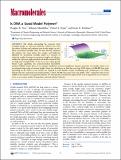| dc.contributor.author | Tree, Douglas R. | |
| dc.contributor.author | Muralidhar, Abhiram | |
| dc.contributor.author | Doyle, Patrick S. | |
| dc.contributor.author | Dorfman, Kevin D. | |
| dc.date.accessioned | 2014-11-03T14:08:51Z | |
| dc.date.available | 2014-11-03T14:08:51Z | |
| dc.date.issued | 2013-10 | |
| dc.date.submitted | 2013-08 | |
| dc.identifier.issn | 0024-9297 | |
| dc.identifier.issn | 1520-5835 | |
| dc.identifier.uri | http://hdl.handle.net/1721.1/91257 | |
| dc.description.abstract | The details surrounding the crossover from wormlike-specific to universal polymeric behavior has been the subject of debate and confusion even for the simple case of a dilute, unconfined wormlike chain. We have directly computed the polymer size, form factor, free energy, and Kirkwood diffusivity for unconfined wormlike chains as a function of molecular weight, focusing on persistence lengths and effective widths that represent single-stranded and double-stranded DNA in a high ionic strength buffer. To do so, we use a chain-growth Monte Carlo algorithm, the pruned-enriched Rosenbluth method (PERM), which allows us to estimate equilibrium and near-equilibrium dynamic properties of wormlike chains over an extremely large range of contour lengths. From our calculations, we find that very large DNA chains (≈1 000 000, base pairs depending on the choice of size metric) are required to reach flexible, swollen nondraining coils. Furthermore, our results indicate that the commonly used model polymer λ-DNA (48 500, base pairs) does not exhibit “ideal” scaling but exists in the middle of the transition to long-chain behavior. We subsequently conclude that typical DNA used in experiments are too short to serve as an accurate model of long-chain, universal polymer behavior. | en_US |
| dc.description.sponsorship | National Science Foundation (U.S.) (Grant 0852235) | en_US |
| dc.description.sponsorship | National Institutes of Health (U.S.) (R01-HG005216) | en_US |
| dc.description.sponsorship | National Institutes of Health (U.S.) (R01-HG06851) | en_US |
| dc.language.iso | en_US | |
| dc.publisher | American Chemical Society (ACS) | en_US |
| dc.relation.isversionof | http://dx.doi.org/10.1021/ma401507f | en_US |
| dc.rights | Article is made available in accordance with the publisher's policy and may be subject to US copyright law. Please refer to the publisher's site for terms of use. | en_US |
| dc.source | MIT web domain | en_US |
| dc.title | Is DNA a Good Model Polymer? | en_US |
| dc.type | Article | en_US |
| dc.identifier.citation | Tree, Douglas R., Abhiram Muralidhar, Patrick S. Doyle, and Kevin D. Dorfman. “Is DNA a Good Model Polymer?” Macromolecules 46, no. 20 (October 22, 2013): 8369–8382. | en_US |
| dc.contributor.department | Massachusetts Institute of Technology. Department of Chemical Engineering | en_US |
| dc.contributor.mitauthor | Doyle, Patrick S. | en_US |
| dc.relation.journal | Macromolecules | en_US |
| dc.eprint.version | Author's final manuscript | en_US |
| dc.type.uri | http://purl.org/eprint/type/JournalArticle | en_US |
| eprint.status | http://purl.org/eprint/status/PeerReviewed | en_US |
| dspace.orderedauthors | Tree, Douglas R.; Muralidhar, Abhiram; Doyle, Patrick S.; Dorfman, Kevin D. | en_US |
| mit.license | PUBLISHER_POLICY | en_US |
| mit.metadata.status | Complete | |
